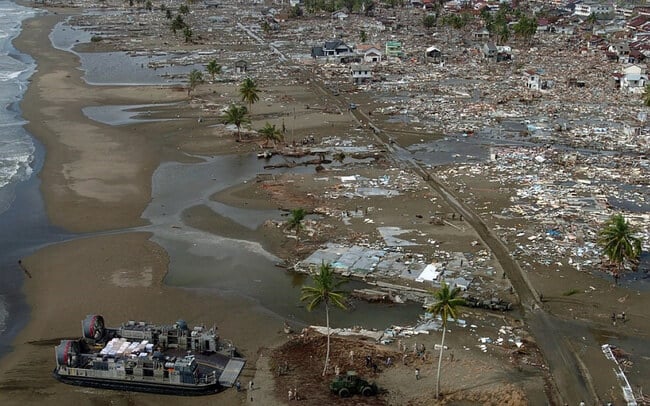26 Dec, 2004 - the saddest day of 21st century
At about 1 a.m. on December 26, 2004, near Simeolue Island, off the west coast of northern Sumatra (Indonesia), one of the three deadliest earthquakes in human history occurred.
 Source:
Source:
The power of nature
The magnitude of the earthquake was 9.3 Mw (moment magnitude scale), only stronger than the strongest earthquake in history with a magnitude of 9.5 Mw in Chile in 1960. The earthquake was followed by a series of deadly tsunamis that spread across the Indian Ocean. Waves as high as 30 meters ravaged coastal communities in Indonesia, Sri Lanka, India, Thailand, Myanmar and elsewhere.The Indian Ocean earthquake shook the ground about 100 times stronger than the Loma Prieta earthquake of 1989. It has the longest duration (between 500 and 600 seconds) that can be recorded. The devastation was recorded within 6,900km of the disaster centre.
The enormous intensity of the Earth's underwater displacement led to the formation of huge waves that swept away from life on nearby islands and as far away as continents. It also triggers damaging earthquakes in other areas - Alaska, the remote coast of Australia, the east coast of Africa. The furthest place where tsunami deaths have been recorded is in Port Elizabeth (South Africa), 8,000km away from the epicentre. The tsunami overcame a distance of 8,500km as far as Struisbaai (South Africa), where 5 hours after the earthquake, it produced high tides of 1.5m.
The epicentre - the point at which the lithosphere shifts itself, lies in the Pacific Ring of Fire - the geographic region that accounts for 80% of all earthquakes that normally occur on Earth. The depth where the earthquake occurred was 30 km from the surface of the world ocean. There was a sudden and very long tectonic plate shift - a giant crack with a length of 1,200-1,600km has formed.
That caused the formation of a giant tsunami. The tsunami waves that arise in the ocean are as destructive as 5 megatons of TNT (20 petajoules). This is twice the total mass of explosives during World War II (including the two atomic bombs dropped on Japan). Waves reach 4km over islands, destroy cities and then sweep them into the ocean. In many places, the tsunami waves reached 2km inland.
The severe consequences
The described movement of the earth's crust takes place in two stages. The interval between tremors lasted for several hours. Even so, residents of all affected countries were taken by surprise. The interesting thing is that animals immediately sense, birds and animals leave all the coastal areas and go deep into the continental parts, but people do not notice. As a result, 235,000 people died, 100,000 people were missing. Source:
Source:
In some areas, fields and drinking water supplies have been contaminated for many years by seawater inundation. There are also concerns about the high mortality rate that will spread diseases such as diarrhoea, diphtheria, dysentery, typhoid and hepatitis A & B, as well as starvation due to high population density and tropical climates in the affected areas. However, due to timely treatment, these risks have been minimized.
Earthquakes and tsunamis can affect waterways passing through the Strait of Malacca by altering seabed depths, disturbing pilot buoys and sinking shipwrecks. Establishing new navigational charts takes months or years. Thailand's Pacific coast resorts, which were not devastated by the tsunami, were devastated by tourists cancelling vacations.
 Source:
Source:
According to experts, the biggest harm is water pollution and soil pollution caused by saltwater from the sea penetrating into the mainland, forming a layer of salt on the surface of cropland. In the Maldives, there are 16 to 17 atolls that are flooded by waves, so there is no fresh water and are considered unrecoverable in the next few decades.
Soils flooded by seawater become barren, making it difficult to restore them to agricultural land. Seawater kills plants and destroys microorganisms that are essential to the soil. Thousands of hectares of rice fields and mango and banana farms in Sri Lanka were completely destroyed and took years to recover.
Share this article
Advertisement